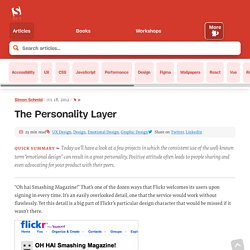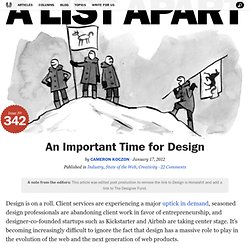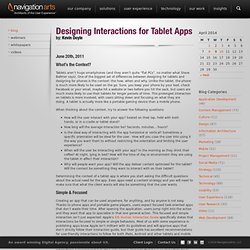

The Personality Layer. Today we’ll have a look at a few projects in which the consistent use of the well-known term “emotional design” can result in a great personality.

Positive attitude often leads to people sharing and even advocating for your product with their peers. “Oh hai Smashing Magazine!” That’s one of the dozen ways that Flickr welcomes its users upon signing in every time. It’s an easily overlooked detail, one that the service would work without flawlessly. Yet this detail is a big part of Flickr’s particular design character that would be missed if it wasn’t there. This is how Flickr greets its users, changing the language upon every sign-in. These easily overlooked details are the ones that I’m particularly interested in because of the reaction they are capable of causing in users. Further Reading on SmashingMag: This positive attitude will often lead to people sharing and even advocating for your product with their peers.
A Little Theory. An Important Time for Design. Design is on a roll.

Client services are experiencing a major uptick in demand, seasoned design professionals are abandoning client work in favor of entrepreneurship, and designer-co-founded startups such as Kickstarter and Airbnb are taking center stage. It’s becoming increasingly difficult to ignore the fact that design has a massive role to play in the evolution of the web and the next generation of web products. This has not gone unnoticed in the startup world. Nearly every CEO and VC I’ve met in the last six months is on a wild hunt for designers. This demand is a powerful tool: it can be used to get more selective with clients, bring design to new markets, and get higher rates—or, it can be used to take aim at something bigger.
The internet, at this time in history, is the greatest client assignment of all time. Ben is right. All eyes on design#section1 The startup world has pinned a great deal of hope on design and is watching to see how it plays out. Design as partner#section2 E. Prophets trends in Interactive Design 2012. Designing Interactions for Tablet Apps. June 20th, 2011 What’s the Context?

Tablets aren’t huge smartphones (and they aren’t quite “flat PCs”, no matter what Steve Ballmer says). One of the biggest set of differences between designing for tablets and designing for phones is the context: the how, when and why. Unlike the tablet, the phone is much more likely to be used on the go. Sure, you keep your phone by your bed, check Facebook or your email, maybe hit a website or two before you hit the sack, but users are much more likely to use their tablets for longer periods of time. When thinking about the context, try to answer the following questions: How will the user interact with your app? Determining the context of a tablet app is where you start asking the difficult questions about the actual need for the app. Simple & Focused Creating an app that can be used anywhere, for anything, and by anyone is not easy. While it’s tempting to use up all the given space, try to resist filling the screen with “cool” interactions.
Fat Fingers.